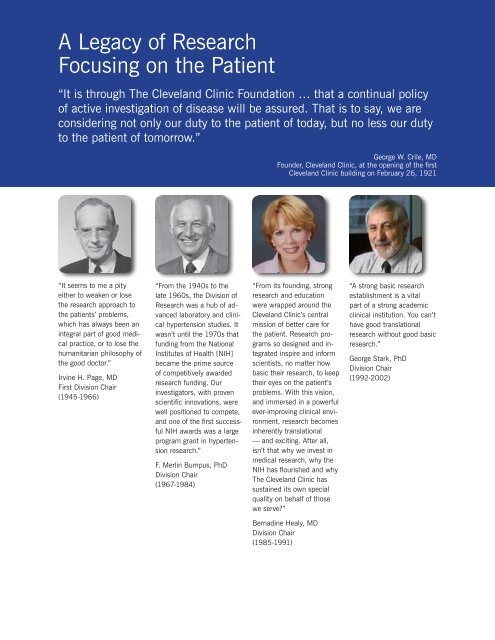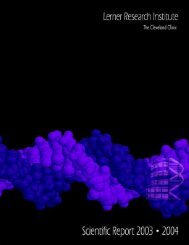Cleveland Clinic Lerner Research Institute
Cleveland Clinic Lerner Research Institute
Cleveland Clinic Lerner Research Institute
You also want an ePaper? Increase the reach of your titles
YUMPU automatically turns print PDFs into web optimized ePapers that Google loves.
A Legacy of <strong>Research</strong><br />
Focusing on the Patient<br />
“It is through The <strong>Cleveland</strong> <strong>Clinic</strong> Foundation … that a continual policy<br />
of active investigation of disease will be assured. That is to say, we are<br />
considering not only our duty to the patient of today, but no less our duty<br />
to the patient of tomorrow.”<br />
George W. Crile, MD<br />
Founder, <strong>Cleveland</strong> <strong>Clinic</strong>, at the opening of the first<br />
<strong>Cleveland</strong> <strong>Clinic</strong> building on February 26, 1921<br />
“It seems to me a pity<br />
either to weaken or lose<br />
the research approach to<br />
the patients’ problems,<br />
which has always been an<br />
integral part of good medical<br />
practice, or to lose the<br />
humanitarian philosophy of<br />
the good doctor.”<br />
Irvine H. Page, MD<br />
First Division Chair<br />
(1945-1966)<br />
“From the 1940s to the<br />
late 1960s, the Division of<br />
<strong>Research</strong> was a hub of advanced<br />
laboratory and clinical<br />
hypertension studies. It<br />
wasn’t until the 1970s that<br />
funding from the National<br />
<strong>Institute</strong>s of Health [NIH]<br />
became the prime source<br />
of competitively awarded<br />
research funding. Our<br />
investigators, with proven<br />
scientific innovations, were<br />
well positioned to compete,<br />
and one of the first successful<br />
NIH awards was a large<br />
program grant in hypertension<br />
research.”<br />
F. Merlin Bumpus, PhD<br />
Division Chair<br />
(1967-1984)<br />
“From its founding, strong<br />
research and education<br />
were wrapped around the<br />
<strong>Cleveland</strong> <strong>Clinic</strong>’s central<br />
mission of better care for<br />
the patient. <strong>Research</strong> programs<br />
so designed and integrated<br />
inspire and inform<br />
scientists, no matter how<br />
basic their research, to keep<br />
their eyes on the patient’s<br />
problems. With this vision,<br />
and immersed in a powerful<br />
ever-improving clinical environment,<br />
research becomes<br />
inherently translational<br />
— and exciting. After all,<br />
isn’t that why we invest in<br />
medical research, why the<br />
NIH has flourished and why<br />
The <strong>Cleveland</strong> <strong>Clinic</strong> has<br />
sustained its own special<br />
quality on behalf of those<br />
we serve?”<br />
“A strong basic research<br />
establishment is a vital<br />
part of a strong academic<br />
clinical institution. You can’t<br />
have good translational<br />
research without good basic<br />
research.”<br />
George Stark, PhD<br />
Division Chair<br />
(1992-2002)<br />
Bernadine Healy, MD<br />
Division Chair<br />
(1985-1991)

















